Published: April 2001
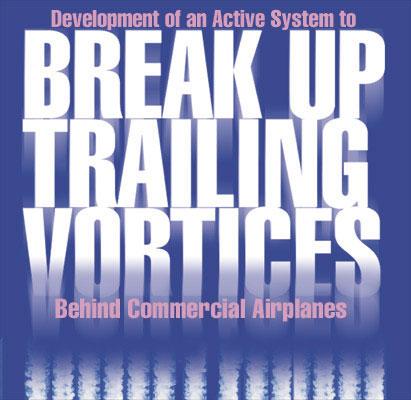
Airplane trailing vortices, often referred to as wake turbulence, are a potential safety issue for trailing airplanes, which may experience a hazardous rolling motion if the vortices are encountered. The avoidance of trailing vortices has led to the establishment of minimum separation distances among airplanes on approach to the same airport under instrument flight rules. These separations have started to limit the capacity at some airports. Boeing is working to develop an active-control system to break up the vortices within a known distance, which is less than some current approach separation distances. Further development and implementation of the system depend on continued technical success and the engagement of all affected parties, including airplane manufacturers, flight crews, airlines, airport authorities, air-traffic controllers, and regulatory authorities.

Trailing vortices are an unavoidable by-product of finite-span lifting wings. Differences in pressure between the upper and lower surfaces of the wings produce swirling vortices that trail the airplane as it flies through the air. These vortices can persist for several minutes, which translates to many miles behind the generating airplane (figure 1). Under most circumstances, the vortices propagate downward away from the flight path or they are carried away by crosswinds. To avoid vortex encounters, minimum separation distances are imposed for airplanes on approach to the same airport under instrument flight rules. This allows time for the vortices to move out of the flight path. The imposed separation distances are key elements affecting airport capacity.

In an effort to improve airport capacity and reduce air-traffic delay, Boeing is developing an active system for vortex destruction that has the potential to safely reduce the required separation distances. The idea is to disorganise the vortices so that an encounter would result in a bumpy motion but not a hazardous rolling motion. The system concept has been validated in ground-based tests in wind tunnels and tow tanks, and detailed development and technical assessment are under way. The system has not yet been tested in flight. In addition to continued technical success, use of the system will require broad industry and regulatory support. To appreciate the essential features of the active system and the potential benefits of implementation, the following need to be understood:
- Physics of trailing vortices behind flaps-down configurations.
- Active-system concept.
- Development status.
- Issues for implementation.
1. PHYSICS OF TRAILING VORTICES BEHIND FLAPS-DOWN CONFIGURATIONS
Multiple vortex pairs.
Commercial airplanes with flaps extended produce multiple trailing vortices that remain distinct for some distance behind the airplane. In the simplest case, the wing produces tip vortices at the wingtips and flap vortices at the outboard edge of the inboard flaps. These two pairs of co-rotating vortices and a pair of counter-rotating vortices from the horizontal tail form the basic flaps-down vortex system (figure 2). Details of the airplane configuration determine how far behind the airplane that the multiple vortex pairs remain as distinct vortices.
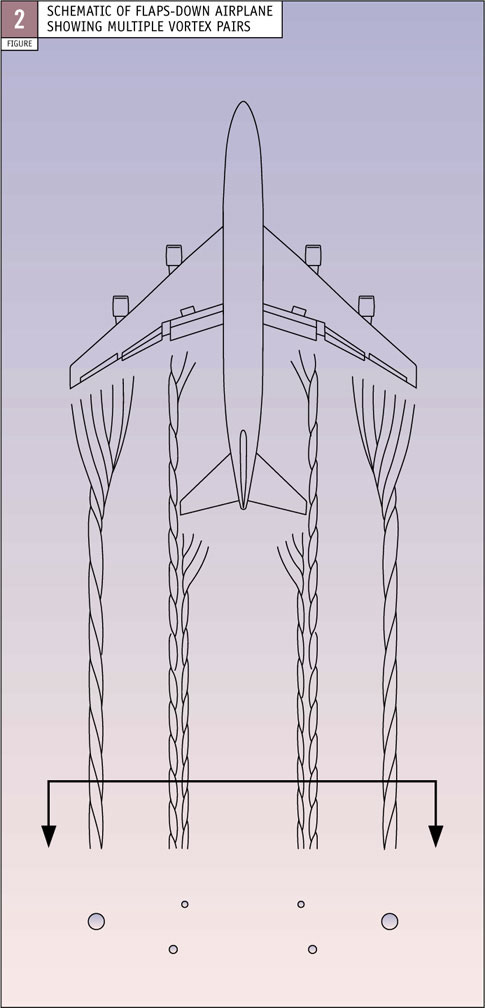
Vortex instabilities.
In general, airplane trailing vortices are weakly unstable. If the vortices are wavy (rather than straight lines), the waviness may grow as a result of this natural instability. In some cases, the waviness of the vortices can become so large that the vortices from the left and right wings touch at different points along their length. At these points, the vortices from the left and right wings link together and produce a series of vortex rings. This process can sometimes be observed in contrails, where condensation provides a marker for the vortices. In this case, background turbulence provides the initial waviness.
There are different instabilities associated with a single vortex pair and with the multiple vortex pairs of flaps-down configurations. The instability of a single vortex pair has been found to amplify the waviness too slowly to help break up the vortices in practice. The multiple-vortex system has instabilities that can grow more rapidly. In particular, when the waviness of the flap vortices is out of phase with the waviness of the tip vortices, a strong amplification results. The active-control system under development introduces this form of waviness to trigger the multiple-vortex-pair instabilities. Growth of the instabilities leads to the break-up of the vortices into a series of vortex rings. Typical wavelengths used to break up the vortices are four to five times the airplane wing span.
2. ACTIVE-SYSTEM CONCEPT
The active system uses periodic oscillations of the control surfaces to shift a small percentage of the lift between inboard and outboard sections of the wing. The outboard ailerons and the inboard flaperons or spoilers are driven symmetrically (i.e., producing no rolling moment) but out of phase to preserve total airplane lift. Any variation in the pitching moment is trimmed out using the elevator. This control input introduces the desired waviness leading, after sufficient amplification, to the break-up of the vortices into vortex rings (figure 3). Numerical simulations of the vortex dynamics provide an initial demonstration that the break-up is achieved when the proper vortex waviness is introduced.
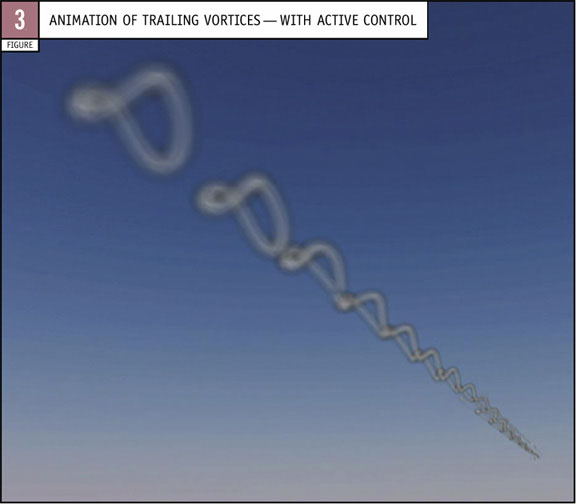
For a large airplane, the control surfaces would be driven at about one cycle every four to five seconds. The control-surface oscillations are driven automatically as part of the flight-controls system. The system would be activated only for the final approach (i.e., with landing flaps). This translates to about 30 to 50 cycles of operation per flight.
Under most circumstances, the vortices propagate downward, or laterally, away from the flight path — just as they do without active control. Thus, vortex avoidance is still the norm. In the unusual event where the vortices might be encountered, the active system would ensure that the vortices have undergone a break-up to a benign state within the airplane-separation distance.
3. DEVELOPMENT STATUS
Ground-based testing.
To demonstrate the active-system concept, a series of ground-based tests was conducted. The break-up of the vortices is expected to occur at distances greater than 50 spans behind the airplane. Because this is beyond the distances achievable with good flow quality in wind tunnels, the active demonstration test was conducted in a water-towing tank. The overall test approach consisted of three stages:
- First, wind-tunnel wake surveys were conducted behind existing airplanes in the flaps-down approach configuration. The surveys provided the detailed distribution of the vorticity just downstream of the airplane.
- Second, wind-tunnel wake surveys were conducted behind a model designed for active testing in a towing tank. The model was designed so that it could be easily modified to produce different distributions of vorticity. Using the surveys behind existing airplanes, the towing-tank model was modified to produce vorticity distributions representative of real airplanes (although not exactly mimicking any particular airplane).
- Third, the towing-tank model was tested in a towing tank to study the farfield development of the vortices, which were marked using fluorescent dye. The system performance was measured by the time required for the vortices to break up into vortex rings. Although not a definitive measure, this break-up time can be scaled to flight conditions for an assessment of performance on different airplanes.
Ground-based test results.
The principal results of the active-system tests can be summarised as follows:
- Break-up into vortex rings was achieved using a moderate level of active-control input.
- When scaled to flight for a large airplane, break-up into vortex rings was achieved at a distance of about 2.5 to 3 nm behind the airplane. Under the current rules, an airplane the size of a 737 may follow 5 nm behind an airplane the size of a 747.
- Without active control and with a low level of environmental turbulence, the vortices did not break up within a distance of 7 nm (when scaled to flight for a large airplane). Recall that current separation distances allow time for the vortices to be carried away from the flight path.
- The performance of the active system depended on details of the airplane configuration (e.g., the flap system and the horizontal-tail loads).
- Experimental results are in general agreement with the numerical simulations.
These results are illustrated by the computer animations in figure 4. The trailing vortices are shown at 1, 2, and 3 nm behind an airplane with the active system and behind an airplane without the system. A passenger view of the airplane wing with the control surfaces at the extreme positions for typical active-control input is shown in figure 5.
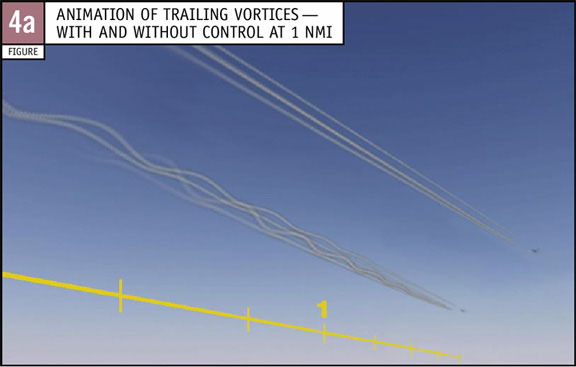
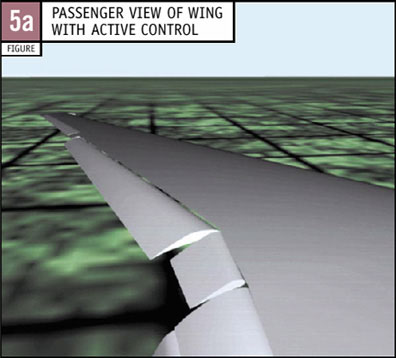

4. ISSUES FOR IMPLEMENTATION
Flight-test validation.
The ground-based tests were designed to model the vortices in flight. There are differences between the test model and a flight airplane, however, that could prove to be significant. Thus, flight-test validation is required. The first issues to be considered in flight are those that could affect the persistence of the multiple vortex pairs. These include the following:
- Engine thrust, which was not included in the ground test because of modelling complexity.
- Reynolds-number scaling, which relates the speed and size of airplanes tested on the ground with those in flight. The model scale in the ground test was approximately 50 times smaller than at flight conditions.
- Configuration differences between the test model and actual airplanes. The towing-tank model was not a geometric replica of a flight airplane because it was designed to study a range of airplane configurations, and it had to operate at a much-reduced Reynolds number.
Open technical issues.
Beyond the validation flight test, a number of other issues need to be addressed before implementation of the active system. These issues are being studied by Boeing and include the following:
- Establishing a measure to help determine the appropriate separation distances. This requires determining at what stage of the break-up the vortices can be considered benign (i.e., more like random turbulence). Vortex rings are expected to be less dangerous than straight trailing vortices, but some further vortex destruction will likely be required.
- Determining how the break-up is affected when the vortices are close to the ground.
- Understanding the impact of environmental effects such as atmospheric stratification and shear winds.
- Developing the necessary system reliability to ensure that the system is operating properly.
Characterising the benefits.
The fundamental benefit of implementing an active system for vortex alleviation is a reduction in required airplane separation distances. Before implementation, all affected parties must be involved in establishing the metrics for evaluating system performance. These metrics will serve as the basis for measuring system success.
The context in which the system is implemented will determine how the benefits of reduced separations are ultimately realised. For example, airports could benefit from an increase in capacity and a reduction in delays. Some portion of these benefits could be passed on to the airlines that use the active system through additional landing slots or reduced landing fees. The benefits will need to be weighed against the cost of implementation. Ultimately, the successful implementation of this technology will require the involvement of all affected parties, including airplane manufacturers, flight crews, airlines, airport authorities, air-traffic controllers, and regulatory authorities.
SummaryBoeing is developing a system that shows promise for breaking up trailing vortices behind flaps-down commercial airplanes within distances less than some current approach separations. The system uses control surfaces to cyclically shift a small fraction of the lift between inboard and outboard sections of the wing to trigger wake instabilities that destroy the vortices. The system has been demonstrated in ground-based testing, but outstanding technical issues are still being addressed and the system must be validated in flight. Along with continued technical success, future development and use of the system will require broad industry and regulatory support. |
JEFFREY CROUCH
ASSOCIATE TECHNICAL FELLOW
ENABLING TECHNOLOGY RESEARCH
BOEING COMMERCIAL AIRPLANES GROUP
GREGORY MILLER
ENGINEER
ENABLING TECHNOLOGY RESEARCH
BOEING COMMERCIAL AIRPLANES GROUP
PHILIPPE SPALART
TECHNICAL FELLOW
ENABLING TECHNOLOGY RESEARCH
BOEING COMMERCIAL AIRPLANES GROUP
| Top of page | Boeing Home | Boeing Commercial | Contact Aero |
Aero Copyright © 2003 The Boeing Company. All rights reserved.